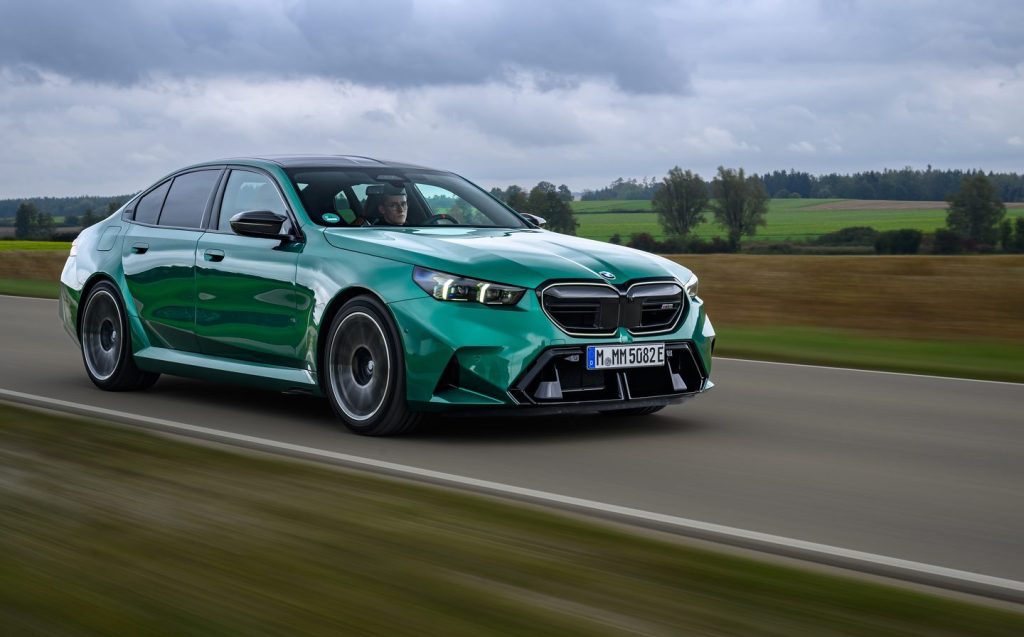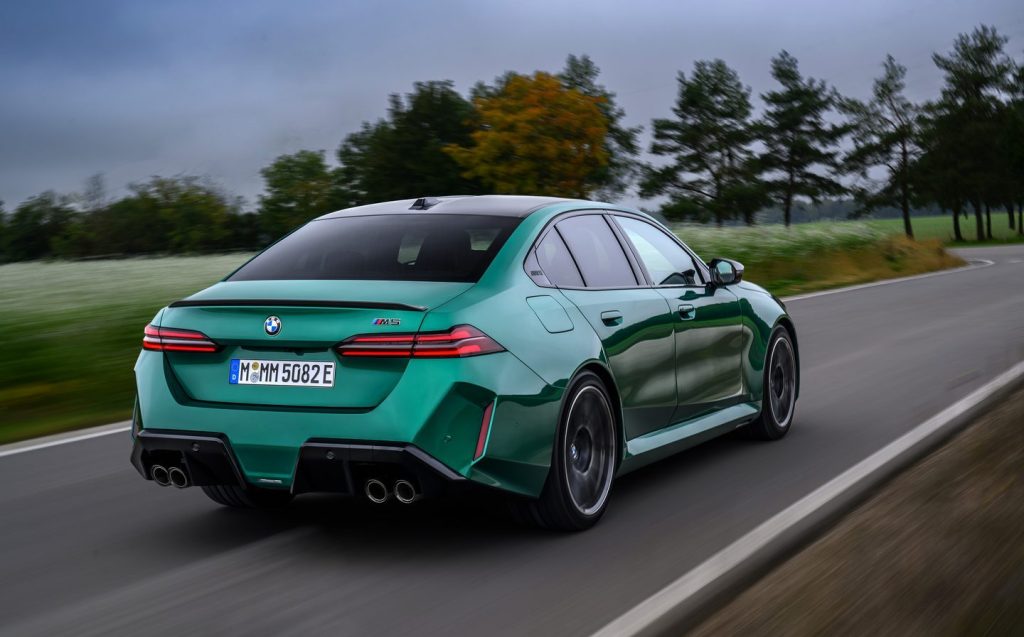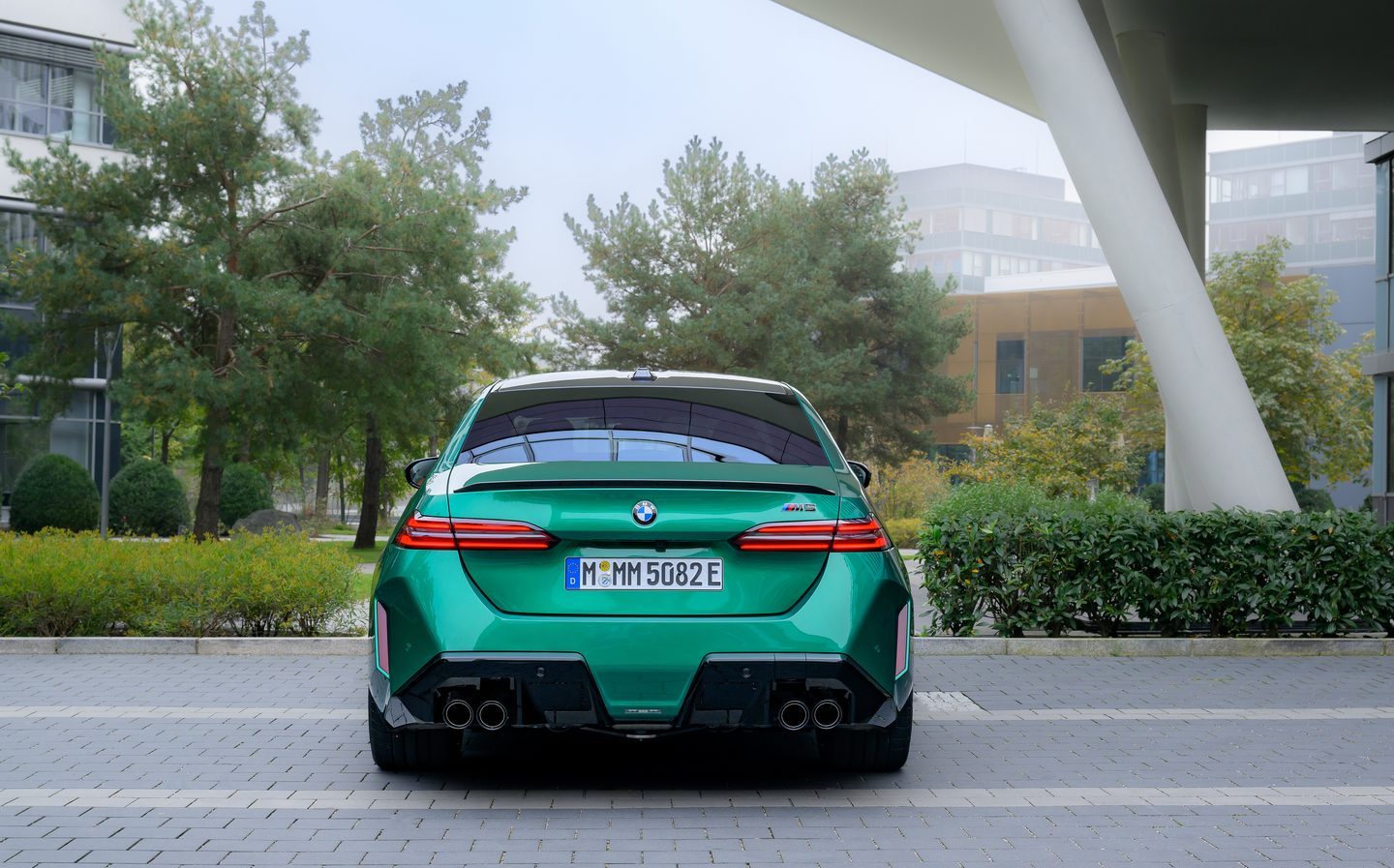BMW M5 PHEV 2024 review: The most explosive M-saloon yet ... but is a plug-in hybrid right?
Does your BMW even lift, bro?
Helmut Kohl really was a remarkable politician. Presiding for many years over a Germany at first divided and eventually reunited, he was a big man, both physically and legislatively, but he seemed to wear both his personal size and his political heft with ease and grace. Kohl’s legacy is a complex one, not least because the way Germany’s reunification was managed in the 1990s has, in some ways, laid the groundwork for the recent reawakening of the far right.
But perhaps BMW was thinking of old Helmut when it sat down to design the new M5. Let’s create a car with staggering power and equally staggering weight, the Munich company decided, and yet make it cope with both in a surprisingly elegant way.

The M5 recipe has long since been understood. BMW wasn’t the first to put a highly-tuned engine into a four-door saloon car — Mercedes got there way before it with the 350 SEL 6.3 in the 1960s — but the original M5 from 1984 (“E28” if you know your BMW product codes) still feels like the starting line for the high-performance saloon.
It was defined by its discreet, sober styling and a high-quality, practical cabin wrapped around a racing-spec engine: in the E28’s case, literally so, as it was the 3.5-litre straight-six unit from the BMW M1, a machine designed for the Procar race series that was turned into a road car.
Every M5 since has retained that mixture almost exactly, albeit with steadily rising levels of bling and body kit as the clientele’s taste has changed. You cannot imagine mixed martial artist Conor McGregor driving an E28 M5, but you could easily see him in this new G90 version. Quite what that says about the relative desirability of the two cars is as yet unknown.
The M5’s steady evolution led, three years ago, to the creation of the truly remarkable M5 CS, based on the “F90” version. Its combo of 626bhp turbocharged V8 and amazingly deft chassis and steering reflexes seemed to put a potential cap on M5 development. Where, after all, could the M5 go next?

Well, upward in power and outward in girth it would seem. Being based on the current “G90” 5 Series means that the new M5 was never going to be a flyweight, and the current electric imperative meant that it was also, for the first time, going to have to be a hybrid. Actually, a plug-in hybrid so on paper this is the saintliest M5 of all time, with an emissions rating of just 39g/km. For reference, the rather humbler 520i today emits over 130g/km on the same test cycle.
The hefty battery that lies under the floor of the new M5 has a capacity of big 18.6kWh and can be fully charged up from a 7kW AC home wallbox in a little more than three hours, giving its owner a potential 42 miles of electric-only range. The M5’s 145kW electric motor means that even on battery-only power, it’s hardly sluggish, as that translates to 194bhp.

All of which is, of course, not the point. For that electric motor combines with the M5’s 4.4-litre twin-turbo V8 engine for a combined maximum of 717bhp. Consider that for a moment. More than 700bhp would, not very long ago, have been a respectable power output for a Le Mans racing prototype.
Indeed, BMW is trying to draw a direct parallel between the M5’s powertrain and that of the BMW M Hybrid Le Mans racer (skimming over the fact that the engine and motor combo has also been used in the execrable XM SUV, and that both the Le Mans cars ended up either in the barrier or in the garage for an early bath at this year’s 24-hour race).
‘The M5 has such a ridiculous torque output that even trying to pull away gently with some steering lock on makes it seem as if you’re ripping whole tread-blocks out of the tyres.’
The thing is that once you put a big battery, and then a big engine, and then a fuel tank, and then suspension, brakes and steering which are up to the task, plus a luxurious interior and so on into one car, you’re going to end up with some weight. Quite a lot of weight.

While it would be unfair of me (and my own excess) to point out someone else’s weight gain, there’s no way of getting around the M5’s 2.5-tonne corpulence. That’s SUV weight, and big SUV weight at that. The M5 has never been a car built around Lotus-like litheness — the last-generation weighed 1,900kg — but even so, this seems like a lot of poundage to be perambulating.
While it might be chunky, the new M5 does at least look the part — especially in one of the more daring colour choices, such as Isle Of Man Green (as pictured) or Daytona Violet — and the M design team, led by Michael Scully, have given the car an appropriate sense of menace thanks to deep front and rear aero surfaces, a mixture of 20- and 21in alloy wheels (the bigger ones at the back for a proper dragster stance) and subtly but unmistakably bulging wheelarches. Remember in the film True Lies, when Arnold Schwarzenegger was crammed into a tuxedo, like muscular concrete poured into a snug mould? Yes, that.
Inside, the cabin is basically that of the standard i5 and 5 Series, aside from the prerequisite bright red items — starter button, steering wheel flash, and M1 and M2 driving mode memory buttons — and a set of the finest bucket seats I’ve ever sat on.

Overall quality levels are phenomenal, bar some nasty cheap plastic around the electric window switches, and if the look of the cabin is a touch chintzy (especially with some of the more outré leather colour choices) then at least it’s warmer and more welcoming than the cold and hard-edged look of an Audi RS 6.
The big, sweeping screens atop the dash are as impressive to look at as they are fiddly to use (even with the retention of the classic iDrive click wheel) and while space in the back seats is better than fine, the boot measures a rather stingy 466 litres when that aforementioned 520i accommodates 520 litres.
Thumb the theatrically red button and, most of the time, you will hear a soft electronic chime instead of the whirr of a starter motor and the bark of the V8. The M5 has been designed to maximise its hybrid ability until you tell it otherwise, and its official 42-mile range on one charge seems broadly realistic unless you’re caning it. The 166mpg fuel economy figure is rather less likely to live on Reality Street, but BMW’s own figure of 26mpg when driving on a flat drive battery seems more like it.

A quick prod of the big throttle pedal awakens the V8, smooth but distantly menacing in its timbre, even if the knowledge that it’s digitally augmented by BMW’s “Iconic Sounds” system is a touch disappointing. And while you can spend hours fiddling with all the variable driving mode settings, thankfully it doesn’t take long to set up a lo-fi group of settings assigned to the M1 steering wheel button, and a more Spinal Tap-like group assigned to M2.
And off into the first dynamic slip up. The M5 has such a ridiculous torque output (twisting force) — up to 737lb ft — that even trying to pull away gently with some steering lock on makes it seem as if you’re ripping whole tread-blocks out of the tyres.
Thankfully, there’s standard four-wheel drive to spread the risk, though there is a leave-your-brain-at-home mode that locks the M5 into rear-wheel drive with no traction control active. Make sure your Michelin futures options are safely invested before trying that one.

Aside from that, for the first few miles, you’re not really aware of the M5’s weight. As with previous models, at low effort it’s just a 5 Series with sportier suspension, so you can bumble along in silence and comfort. Our first few minutes with the car were on a speed-limited section of Autobahn outside Munich, and at 75mph the big BMW removed any sense of effort from the equation.
Then the speed limit ended and the famous three slim black lines on a white background sign hove into view, signalling a derestricted section of Autobahn. And then the M5 showed what it can do.

Blimey. Notionally, the M5 has the same 155mph speed limiter as other BMWs, but there is the option to have that removed, and a 189mph limiter applied instead, which is of course of academic interest in most countries … but not in Germany. At an indicated 169mph, the M5 was still pulling with maximum vigour when gathering traffic ahead made us think twice about our own mortality, and that of others.
This is a savagely fast car. Technically, it’s slower by 0.5 seconds to get to 62mph than was the previous-generation M5 CS — 3.5 seconds for the new car — but it’s with the in-gear acceleration times, helped by that ridiculous torque figure, that the new M5 takes the old one to the cleaners. Use the carbon-fibre paddles behind the steering wheel to downshift into fourth, and the new M5 will get from 50mph to 75mph in 2.2 seconds. Weight be damned.

If you were in any doubt about how serious a plug-in hybrid M5 might feel, this should do the trick. It transcends the traditional power pauses of a combustion engine, so it’s not so much suck-squeeze-bang-blow as it is stomp, scream, whoosh, arrive. You’d think 717bhp would just be too much for a road-going car, but no — the M5 takes such power (aside from some occasional uncouth driveline slap on part-throttle) in its stride.
‘At an indicated 169mph, the M5 was still pulling with maximum vigour when gathering traffic ahead made us think twice about our own mortality’
Straight-line speed was arguably never in doubt, but more worrying for the M5’s more traditional fans is that weight figure. How could BMW take something so heavy and make it dance?
Well, it has. The M5 is not perfect, and yes you can sense that massive weight, especially under braking for a tight corner, or in the occasional shimmy as the springs try to keep all the mass in the right place. But considering just how hefty it is, the M5 really does feel remarkably athletic.
The steering is sharp and communicative enough that you feel totally confident placing this broad-shouldered car on narrow country roads. Direction changes need maybe half-a-breath longer for the M5 to settle its weight than it would have done before, but even so it feels staggeringly hooked-up and utterly biddable.

The rear-wheel steering — a first for an M5 — doubtless helps. Unlike some other such applications you’re never really aware of the back wheels changing angle, so it’s a subtle effect, but the ability to make the M5 feel more secure and planted at higher speeds, and more agile at slower ones, has definitely helped to mask much of the weight gain.
BMW’s engineers admit that they considered an active anti-roll system, too, but rejected it because it would have been too heavy and too expensive. Thank heavens for this, because the M5 is slightly softer on its springs than you might expect, and that allows a touch of body roll. Far from being a criticism, this is a boon for a keen driver, as the roll helps to tell you exactly what the car is doing, and how close you are to brushing the limit.

The brakes — optionally equipped with massive carbon-ceramic discs — feel a touch soft at first, but bite firmly and reassuringly with a harder press of the pedal.
So no, the new M5 isn’t as scalpel sharp as the old M5 CS. Nor could it truly ever be. But it gets much closer than we could have hoped, and of course for all its incredible talents, the M5 CS could never electrically dodge the taxman in the way that the new M5 can. Arguably, that’s probably of more benefit to potential owners.

Of which there should be more than several. BMW’s M division is in something of a purple patch right now, with sales rising across the world — thanks, say M division head honchos, to the fact that the brand now offers regular petrol cars, hybrids and pure-electric models. Indeed, the i5 M60 electric saloon is currently the best-selling M-badged model of all.
Helmut Kohl may have put Germany back together again, but the new M5 has arguably done something much harder: it has put hybrid power and driving enthusiasm together.
Related articles
- If you found this review of the new BMW M5 interesting, you might also like to read our review of the BMW M3 Touring
- Have you seen the next-generation BMW M2?
- Any interest in the all-electric Audi A6 e-tron?
Latest articles
- Five best electric cars to buy in 2025
- Should I buy a diesel car in 2025?
- F1 2025 calendar and race reports: The new Formula One season as it happens
- Zeekr 7X AWD 2025 review: A fast, spacious and high tech premium SUV — but someone call the chassis chief
- Denza Z9GT 2025 review: Flawed but sleek 1,062bhp shooting brake from BYD’s luxury arm
- Extended test: 2024 Renault Scenic E-Tech review
- Best-selling cars 2025: The UK’s ten most popular models of the year so far
- Audi A6 Avant 2025 review: Trusty executive estate ticks expected boxes, and there’s still a diesel option
- Keir Starmer eases pressure on carmakers to sell EVs in response to ‘global economic headwinds’






















